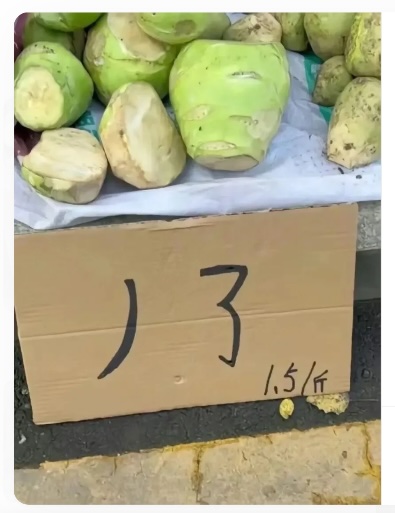Extreme simplification and phoneticization
« previous post | next post »
Probably only Northeastern Chinese could understand.

(source)
"丿" is a stroke in the Chinese writing system, named "piě 撇" (defined as "a stroke that falls downwards towards the left"). "了" (le) is a suffix that represents perfect tense in MSM. So together, the sound of "piě-le 丿了" is slurredly homophonous to that of 苤蓝 (MSM: piělán) in Northeastern Chinese topolect. Piělán 苤蓝 is kohlrabi, a vegetable of the brassica family that is native to north China. It is precisely what this stand sells.
As Diana Shuheng Zhang, a Northeasterner who sent in this photograph and its description, says, "What an ingenious simplification of the complicated hanzi writing for the vegetable! Two most interesting aspects: 1. it does not use pinyin or the Roman alphabet as a solution; 2. it is based on topolect".
Selected readings
"For you, broccoli rabbi, but NO BIKES" (2/16/08)
"Napa cabbage" (1/16/21)
Cf. the numerous LL posts on Chinese restaurant shorthand.
Jenny Chu said,
November 19, 2023 @ 7:43 am
Out of curiosity, is there anything particularly blue about kohlrabi? Or is the second character unrelated to the color?
mirrorwitch said,
November 19, 2023 @ 8:03 am
Are the words phonetically closer in Northeast pronunciation than mainstream Mandarin? If so I'd love details on how.
Victor Mair said,
November 19, 2023 @ 9:05 am
@Jenny Chu
You have asked such an excellent question that I will write a separate post on this puzzle, one that will lead us through Iranian, Turkic, and Greek languages.
Victor Mair said,
November 19, 2023 @ 9:15 am
@mirrorwitch
I wrote "slurredly homophonous".
Michael Watts said,
November 19, 2023 @ 10:03 am
I can have difficulty hearing the difference between Mandarin syllables ending in -n, -ng, or sometimes even -zero (where the syllable should end in -n, but I hear nothing), so it's easy for me to believe that le and lan might be slurredly homophonous.
I always feel especially embarrassed about not hearing the difference between -n and -ng because, after all, that very contrast is robustly drawn in my native English. I don't have trouble hearing it there!
Presumably what's going on is some combination of (1) Chinese people who don't make this distinction — I am told this is a feature of 江苏话, I think? ; (2) the otherwise different phonology of Mandarin messing up whatever methods I normally use to distinguish -n from -ng; and perhaps (3) the distinction between /n/ and /ŋ/ being somehow different in Mandarin than it is in English?
Jonathan Smith said,
November 19, 2023 @ 10:52 am
Sorry @mirrorwitch — indeed, since Diana Shuheng Zhang says that the sign "is based on topolect," we can guess that this rendering matches local pronunciation better than it does MSM. The internet confirms, if imprecisely: 北方人称之为piele "northerners call it [i.e. kohlrabi] piele".
Chris Button said,
November 19, 2023 @ 7:28 pm
Is there vocalic nasalization in this topolect? I'm thinking lә̃ or lã some such thing–hence the convergence?
Chris Button said,
November 19, 2023 @ 7:35 pm
A look at the intonation might be informative too–particularly if we're dealing with a "neutralized" tone on the second syllable.